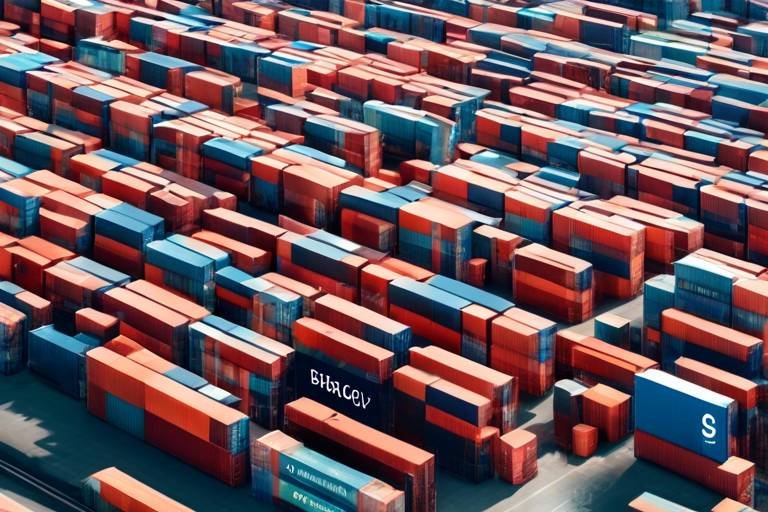The Role of Blockchain in Enhancing Supply Chain Transparency
In today's fast-paced world, the need for transparency in supply chains has never been more critical. Consumers are more informed and concerned about where their products come from and how they are made. Enter blockchain technology, a game-changer that promises to enhance transparency, traceability, and efficiency in supply chains. Imagine a world where every transaction is recorded in a secure, immutable ledger that anyone can access. This is not just a dream; it’s a reality that blockchain technology is making possible. By leveraging this innovative technology, businesses can build more trusted and resilient systems, ultimately leading to better consumer satisfaction and loyalty.
So, what exactly is blockchain? At its core, blockchain is a decentralized ledger system that records transactions across multiple computers. This means that no single entity owns the data, making it inherently more secure and resistant to tampering. Key features of blockchain include:
- Immutability: Once data is recorded, it cannot be altered or deleted, ensuring the integrity of the information.
- Transparency: All participants in the network can view the same data, fostering trust among stakeholders.
- Security: Advanced cryptography protects data, making it nearly impossible for unauthorized users to access or alter it.
These features make blockchain an ideal candidate for improving supply chain transparency, allowing all parties involved to have a clear view of the entire process from production to delivery.
Transparency in supply chains is not just a buzzword; it brings tangible benefits that enhance trust among all stakeholders. When everyone can see the same information, accountability increases, and the risk of fraud diminishes. Here are some of the key advantages:
- Improved Accountability: With clear records of every transaction, companies can hold themselves accountable for their practices.
- Better Risk Management: Transparency helps identify potential risks early, allowing businesses to mitigate them proactively.
- Increased Consumer Confidence: When consumers know they can trace a product back to its source, they are more likely to trust the brand.
In essence, transparency fosters a culture of trust, which is essential for long-term success.
One of the standout features of blockchain is its ability to provide traceability. Imagine being able to track a product from its origin to the consumer's hands. This capability is crucial for businesses that want to verify the authenticity and safety of their products. With blockchain, every step of the supply chain is recorded, allowing companies to trace back through the entire process. This not only helps in ensuring product quality but also in addressing any issues that may arise.
Fraud and counterfeiting are significant threats in the supply chain landscape. Blockchain's immutable records serve as a powerful tool against these issues. By ensuring that every product's journey is documented and accessible, companies can prove the authenticity of their products. This is especially important in industries like pharmaceuticals, where counterfeit drugs can have dire consequences. With blockchain, businesses can confidently assure consumers that what they are purchasing is genuine and ethically sourced.
Compliance with industry regulations is not just a legal requirement; it’s a necessity for building trust with consumers. Blockchain can streamline compliance processes by providing real-time data and documentation for audits and regulatory requirements. This means businesses can easily demonstrate their adherence to standards, reducing the risk of penalties and enhancing their reputation in the market.
Beyond transparency, blockchain technology can significantly enhance operational efficiency. By automating processes and reducing the need for paperwork, businesses can save time and money. Imagine cutting down on the hours spent on manual record-keeping and the costs associated with paper trails. These improvements lead to cost savings across the supply chain, allowing companies to invest more in innovation and customer service.
While the benefits of blockchain are clear, implementing this technology is not without its challenges. Issues such as scalability, integration with existing systems, and the need for industry standards can pose significant hurdles. However, overcoming these challenges is essential for broader adoption in supply chains.
Scalability is a critical issue for blockchain networks. As more participants join the network and transactions increase, current blockchain solutions can struggle to keep up. Addressing these limitations will be key to ensuring that blockchain can support the demands of global supply chains.
Integrating blockchain with legacy systems can be complex and requires careful planning. Businesses must strategize on how to leverage blockchain without disrupting their current operations. This involves identifying the right areas for integration and ensuring that all stakeholders are on board with the transition.
Q: How does blockchain improve supply chain transparency?
A: Blockchain enhances transparency by providing an immutable and decentralized ledger that allows all stakeholders to access the same data, ensuring accountability and trust.
Q: What industries can benefit from blockchain in supply chains?
A: Industries such as food and beverage, pharmaceuticals, and luxury goods can greatly benefit from blockchain technology due to the need for traceability and authenticity.
Q: What are the main challenges of implementing blockchain?
A: The main challenges include scalability, integration with existing systems, and the need for industry standards to ensure compatibility and effectiveness.

Understanding Blockchain Technology
Blockchain technology is often described as a revolutionary force in various industries, and for good reason. At its core, blockchain is a decentralized ledger system that securely records transactions across multiple computers. Imagine a digital notebook that everyone can see but no one can erase or alter. This unique characteristic is what makes blockchain so appealing for applications in supply chain management. The key features of blockchain—immutability, transparency, and security—combine to create a robust framework that enhances trust and efficiency.
The concept of immutability means that once a transaction is recorded on the blockchain, it cannot be changed or deleted. This is akin to writing in ink rather than pencil; once the ink dries, it’s permanent. Such permanence is crucial for supply chains, where maintaining accurate records is vital for accountability and traceability. Additionally, the transparency offered by blockchain allows all stakeholders to access the same information in real-time. This shared visibility helps to eliminate discrepancies and fosters a sense of trust among parties involved in the supply chain.
Moreover, security is another cornerstone of blockchain technology. Each transaction is encrypted and linked to the previous one, creating a chain of blocks that is incredibly difficult to tamper with. This level of security is especially important when dealing with sensitive data, such as product origins and compliance documentation. As a result, businesses can rest assured that the information they rely on is not only accurate but also protected from fraud and manipulation.
To illustrate how blockchain works, consider the following table that outlines its key features and benefits:
| Feature | Description | Benefit |
|---|---|---|
| Decentralization | No central authority controls the data. | Reduces the risk of a single point of failure. |
| Immutability | Once recorded, transactions cannot be altered. | Ensures data integrity and accountability. |
| Transparency | All parties can view the same data in real-time. | Builds trust among stakeholders. |
| Security | Transactions are encrypted and linked. | Protects against fraud and unauthorized access. |
In summary, blockchain technology is not just a buzzword; it is a transformative tool that can fundamentally change how supply chains operate. By leveraging its core features of immutability, transparency, and security, businesses can create a more trusted and resilient system. As we delve deeper into the benefits of transparency in supply chains, it's essential to recognize that understanding blockchain is the first step toward harnessing its full potential.

Benefits of Transparency in Supply Chains
In today's fast-paced world, transparency in supply chains has become more than just a buzzword; it's a necessity. Imagine a world where every stakeholder—from manufacturers to consumers—has real-time access to information about the products they handle. This level of openness fosters trust and accountability, which are crucial for building resilient supply chains. When businesses embrace transparency, they not only enhance their reputation but also create a more efficient system that benefits everyone involved.
One of the most significant advantages of transparency is the ability to improve accountability. When all parties in the supply chain can see the same information, it becomes easier to hold each other responsible for their actions. For instance, if a supplier fails to meet quality standards, stakeholders can trace the issue back to its source, ensuring that corrective measures are taken. This level of accountability reduces the chances of negligence and promotes a culture of responsibility.
Furthermore, transparency leads to better risk management. By having access to detailed information about every aspect of the supply chain, companies can identify potential risks before they escalate into serious problems. For example, if a natural disaster disrupts a key supplier's operations, businesses can quickly pivot to alternative suppliers, minimizing downtime. This proactive approach to risk management not only saves time and money but also reinforces the resilience of the entire supply chain.
Another noteworthy benefit is the increased consumer confidence. Today’s consumers are more informed and concerned about where their products come from. They want to know if the goods they purchase are ethically sourced and produced. Transparency allows companies to share their practices openly, from sourcing materials to labor conditions. When consumers can verify the integrity of a product, they are more likely to trust the brand and make repeat purchases. This trust translates into loyalty, which is invaluable in a competitive market.
To sum it up, the benefits of transparency in supply chains are multifaceted, encompassing:
- Enhanced accountability among stakeholders
- Improved risk management capabilities
- Increased consumer confidence and loyalty
Incorporating transparency into supply chains is not just about improving operations; it's about fostering a culture of trust and collaboration. As businesses continue to navigate the complexities of global supply chains, those that prioritize transparency will not only survive but thrive in the ever-evolving landscape.
Q: How does transparency in the supply chain benefit consumers?
A: Transparency allows consumers to verify the authenticity and ethical sourcing of products, leading to increased trust and confidence in the brands they choose.
Q: What role does technology play in enhancing supply chain transparency?
A: Technology, particularly blockchain, enables real-time tracking and sharing of information across the supply chain, making it easier for all stakeholders to access the same data.
Q: Can transparency reduce costs in the supply chain?
A: Yes, by improving accountability and risk management, transparency can lead to cost savings through more efficient operations and reduced losses from supply chain disruptions.

Traceability of Products
In today’s fast-paced market, ensuring the has become a pivotal aspect of supply chain management. Imagine being able to follow a product's journey from its origin to the final consumer. This capability not only enhances transparency but also builds consumer trust. Blockchain technology serves as a powerful tool in achieving this level of traceability. By utilizing a decentralized ledger, all transactions related to a product are recorded in real-time, creating an immutable history that can be accessed by all stakeholders.
For instance, consider a scenario where a food product is contaminated. With blockchain, it becomes remarkably easy to trace back through the supply chain to identify the source of contamination. This quick response not only protects consumers but also helps businesses mitigate risks associated with recalls and reputational damage. The following table illustrates how blockchain enhances traceability across various industries:
| Industry | Traceability Benefits |
|---|---|
| Food and Beverage | Quick identification of contamination sources, enhancing food safety. |
| Pharmaceuticals | Verification of drug authenticity, reducing counterfeit products. |
| Fashion | Tracking the origin of materials, ensuring ethical sourcing. |
Moreover, blockchain enables businesses to verify the authenticity and safety of their products through a simple scan of a QR code. This not only empowers consumers but also encourages companies to maintain high standards throughout their supply chains. Imagine walking into a store, scanning a product’s QR code, and instantly accessing its entire history—from farm to table or factory to shelf. This level of transparency is not just a trend; it’s a necessity in today’s conscientious market.
Additionally, the ability to trace products back to their source can significantly reduce fraud and counterfeiting. By providing a clear and verifiable chain of custody, businesses can assure consumers that what they are purchasing is genuine. This is particularly important in industries where the stakes are high, such as pharmaceuticals and luxury goods.
In summary, the through blockchain technology not only enhances operational efficiency but also cultivates a culture of transparency and accountability. As consumers become more aware and concerned about the origins of their purchases, businesses that leverage blockchain for traceability will not only stand out but also build lasting trust with their customers.
- What is product traceability? Product traceability refers to the ability to track the history, application, or location of a product throughout the supply chain.
- How does blockchain improve traceability? Blockchain improves traceability by providing a secure, immutable ledger that records every transaction related to a product, allowing for real-time tracking.
- What industries benefit the most from product traceability? Industries such as food and beverage, pharmaceuticals, and fashion see significant benefits from enhanced traceability.
- Can consumers access product traceability information? Yes, consumers can often access product traceability information through QR codes or other digital means provided by brands.

Reducing Fraud and Counterfeiting
In today's global market, fraud and counterfeiting have become rampant issues that threaten the integrity of supply chains. Imagine purchasing a high-end luxury item, only to discover it's a cheap imitation. Frustrating, right? This is where blockchain technology steps in as a game-changer. By utilizing its immutable records, businesses can significantly reduce the risks associated with counterfeit products.
Blockchain's decentralized nature ensures that every transaction is recorded across multiple nodes in the network. This means that once a product's information is entered into the blockchain, it cannot be altered or deleted. For instance, when a manufacturer produces a product, they can log details such as the date of production, materials used, and even the location. This creates a digital fingerprint of the product that can be traced back to its origin at any point in the supply chain.
Furthermore, this level of transparency allows consumers to verify the authenticity of products before making a purchase. Imagine scanning a QR code on a luxury handbag that links to its blockchain record, revealing its entire journey from production to sale. This not only builds trust with consumers but also holds manufacturers accountable for their products. If a counterfeit is detected, the blockchain provides a clear trail to identify where the fraud occurred, enabling swift action against the perpetrators.
To illustrate the impact of blockchain on reducing fraud, consider the following table:
| Traditional Supply Chain Issues | Blockchain Solutions |
|---|---|
| Difficulty in verifying product authenticity | Immutable records provide verifiable proof of origin |
| Complexity in tracking product history | Real-time tracking of products from origin to consumer |
| High risk of counterfeit products | Transparency reduces the chances of fraud |
In addition to enhancing product verification, blockchain technology also fosters collaboration among stakeholders. When suppliers, manufacturers, and retailers share access to the same blockchain, they can work together to ensure that every step of the supply chain is legitimate and transparent. This collaboration can lead to a collective effort in combating fraud, as all parties have a vested interest in maintaining the integrity of their products.
In conclusion, the implementation of blockchain technology is not just a trend; it is a necessity in the fight against fraud and counterfeiting in supply chains. By providing a secure, transparent, and verifiable system, blockchain empowers businesses and consumers alike to trust the authenticity of products. As we move forward, embracing this technology will be crucial for creating a more reliable and resilient supply chain ecosystem.
- What is blockchain technology? Blockchain is a decentralized ledger that records transactions across multiple computers, ensuring transparency and security.
- How does blockchain reduce fraud? By providing immutable records of transactions, blockchain allows for easy verification of product authenticity and traceability.
- Can blockchain be integrated with existing supply chain systems? Yes, while integration can be complex, there are strategies to ensure seamless adoption without disrupting current operations.
- What industries can benefit from blockchain? Various industries, including food, pharmaceuticals, and luxury goods, can leverage blockchain for improved transparency and fraud prevention.

Enhancing Compliance and Regulations
In today's fast-paced business environment, compliance with industry regulations is not just a checkbox to tick off; it's a vital part of maintaining a reputable and trustworthy brand. Blockchain technology shines in this area, acting as a beacon for businesses aiming to enhance their compliance processes. By leveraging a decentralized ledger, companies can streamline their compliance efforts, ensuring they meet regulatory requirements efficiently and effectively.
One of the most significant advantages of using blockchain for compliance is its ability to provide real-time data and documentation. Imagine a world where auditors can access the information they need without sifting through mountains of paperwork. With blockchain, every transaction is recorded and timestamped, creating a transparent audit trail that regulators can easily follow. This not only speeds up the audit process but also reduces the chances of errors and discrepancies that can arise from manual record-keeping.
Moreover, the immutable nature of blockchain records means that once a transaction is logged, it cannot be altered or deleted. This feature is crucial for compliance, as it ensures that all data remains intact and verifiable. Companies can confidently demonstrate their adherence to regulations, knowing that their records are secure and reliable. For instance, in industries like food and pharmaceuticals, where safety is paramount, blockchain can provide proof of compliance with health regulations, ensuring that products are safe for consumers.
To illustrate the impact of blockchain on compliance, consider the following table that outlines the key benefits:
| Benefit | Description |
|---|---|
| Real-Time Data Access | Auditors can access up-to-date information instantly, reducing audit times. |
| Immutable Records | Once recorded, transactions cannot be altered, ensuring data integrity. |
| Enhanced Transparency | All stakeholders can view the same data, fostering trust and accountability. |
| Cost-Effectiveness | Reduced paperwork and manual processes lead to lower operational costs. |
Additionally, blockchain can help businesses stay ahead of regulatory changes. With the ability to quickly adapt and update their compliance protocols, companies can ensure they are always in line with the latest requirements. This agility is particularly beneficial in industries that face frequent regulatory updates, such as finance and healthcare.
In conclusion, enhancing compliance and regulations through blockchain technology is not just about keeping up with the law; it's about building a foundation of trust and reliability in the marketplace. By embracing this innovative technology, businesses can not only improve their compliance processes but also position themselves as leaders in their respective industries.
- What is blockchain technology? Blockchain is a decentralized ledger system that records transactions across multiple computers, ensuring transparency and security.
- How does blockchain enhance supply chain transparency? It provides a clear and immutable record of transactions, allowing stakeholders to track products from origin to consumer.
- What are the compliance benefits of using blockchain? Blockchain offers real-time data access, immutable records, enhanced transparency, and cost-effectiveness, making compliance easier and more reliable.
- Can blockchain help reduce fraud in supply chains? Yes, the immutable nature of blockchain records helps ensure that products are genuine and sourced responsibly, significantly reducing the risk of fraud.

Improving Efficiency and Cost-Effectiveness
In today's fast-paced business environment, efficiency and cost-effectiveness are not just buzzwords; they are essential for survival. Blockchain technology has emerged as a game-changer in supply chains, offering a way to streamline operations and cut costs dramatically. Imagine a world where every transaction is recorded in real-time, where paperwork is minimized, and where processes are automated. This is not just a dream; it is the reality that blockchain brings to the table.
One of the standout features of blockchain is its ability to automate various processes. By leveraging smart contracts—self-executing contracts with the terms of the agreement directly written into code—businesses can eliminate the need for intermediaries. This not only speeds up transactions but also reduces costs associated with manual processing and human error. For instance, consider a scenario where a supplier and a retailer engage in a transaction. With blockchain, once the conditions of the contract are met, the payment is automatically released without any delays or additional fees.
Moreover, the transparency that blockchain provides can lead to significant savings. When all parties in the supply chain have access to the same information, it minimizes disputes and errors. This transparency fosters a collaborative environment where stakeholders can work together more effectively. For example, if a shipment is delayed, everyone involved can see the status in real-time, allowing them to take proactive measures rather than scrambling to resolve issues after the fact.
Furthermore, blockchain's capacity to reduce fraud and counterfeiting also contributes to overall cost savings. By ensuring that every product's journey is traceable, businesses can confidently source materials and products, knowing they are legitimate. This not only protects the brand's reputation but also minimizes the financial losses associated with counterfeit goods. According to a recent study, companies that adopted blockchain saw a reduction in losses due to fraud by up to 30%.
To put things into perspective, let's look at a simple table illustrating potential cost savings from blockchain implementation in supply chains:
| Aspect | Traditional Method Cost | Blockchain Method Cost | Estimated Savings |
|---|---|---|---|
| Transaction Processing | $100 | $60 | $40 |
| Fraud Losses | $50 | $35 | $15 |
| Administrative Costs | $200 | $120 | $80 |
| Total Savings | $350 | $215 | $135 |
As the table shows, transitioning to blockchain can lead to substantial savings across various aspects of supply chain management. Not only does it streamline transaction processes, but it also mitigates risks associated with fraud and administrative overhead. In the long run, these improvements can lead to a healthier bottom line for businesses, allowing them to reinvest in innovation and growth.
In conclusion, the integration of blockchain technology into supply chains is not just about keeping up with the trends; it's about setting the stage for a more efficient, cost-effective future. With its ability to automate processes, enhance transparency, and reduce fraud, blockchain is paving the way for businesses to thrive in an increasingly competitive landscape.
- What is blockchain technology?
Blockchain is a decentralized ledger that records transactions across multiple computers, ensuring transparency and security. - How does blockchain improve supply chain transparency?
By providing a shared, immutable record of transactions, all parties can verify the authenticity and status of products in real-time. - Can blockchain reduce costs in supply chains?
Yes, by automating processes, reducing fraud, and improving operational efficiency, blockchain can lead to significant cost savings. - What are smart contracts?
Smart contracts are self-executing contracts with the terms directly written into code, enabling automated transactions without intermediaries.

Challenges of Implementing Blockchain
While the potential of blockchain technology in supply chains is immense, the road to implementation is not without its hurdles. Many businesses are eager to harness the power of blockchain to enhance transparency and efficiency, but they often encounter significant challenges that can hinder progress. One of the primary concerns is scalability. As a blockchain network grows, the volume of transactions can lead to slower processing times. This can be particularly problematic in supply chains where speed is crucial. Companies need to ensure that their blockchain solutions can handle increased loads without compromising performance.
Another challenge lies in the integration with existing systems. Many organizations have established legacy systems that are deeply embedded in their operations. Integrating blockchain technology with these systems can be a complex task, requiring significant time and resources. Businesses must carefully strategize how to incorporate blockchain without disrupting their current workflows. This often involves re-evaluating processes and possibly overhauling systems to create a seamless transition.
Moreover, the lack of industry standards poses a significant barrier to widespread adoption. Without a common framework or set of protocols, different blockchain implementations can lead to interoperability issues. This fragmentation can create confusion and inefficiencies, making it challenging for companies to communicate and collaborate effectively across the supply chain. Establishing universal standards is critical for fostering trust and ensuring that all parties can benefit from blockchain technology.
Additionally, there is the concern of regulatory compliance. As blockchain technology evolves, so too do the regulations surrounding it. Companies must navigate a complex landscape of laws and guidelines that vary by region and industry. Staying compliant while leveraging the innovative aspects of blockchain can be a daunting task, requiring ongoing education and adaptation.
Finally, the initial costs associated with implementing blockchain can be a deterrent for many businesses. The investment in technology, training, and infrastructure can be substantial. However, it's essential to view these costs as long-term investments that can lead to significant savings and efficiencies down the line. Companies must weigh the upfront costs against the potential benefits to make informed decisions about their blockchain initiatives.
In summary, while the challenges of implementing blockchain in supply chains are considerable, they are not insurmountable. By addressing scalability, integration, standardization, compliance, and cost concerns, businesses can pave the way for a successful transition to a more transparent and efficient supply chain ecosystem.
- What is blockchain technology? Blockchain is a decentralized ledger system that records transactions across multiple computers, ensuring transparency and security.
- How can blockchain improve supply chain transparency? By providing an immutable record of transactions, blockchain enhances traceability and accountability among stakeholders.
- What are the main challenges of implementing blockchain? Key challenges include scalability, integration with existing systems, lack of industry standards, regulatory compliance, and initial costs.
- Is blockchain technology cost-effective? While initial costs can be high, the long-term benefits often outweigh these expenses, leading to significant savings and efficiencies.

Scalability Concerns
When it comes to implementing blockchain technology in supply chains, one of the most pressing issues is scalability. Imagine a bustling marketplace where every transaction needs to be recorded in real-time. As the number of transactions increases, the ability of the blockchain to process and validate these transactions can become strained. This is akin to a highway that becomes congested during rush hour; the more cars (or transactions) you add, the slower everything moves. In the context of supply chains, if blockchain technology cannot handle a high volume of transactions efficiently, it risks becoming a bottleneck rather than a solution.
Current blockchain solutions often face limitations in terms of transaction speed and capacity. For instance, popular blockchains like Bitcoin and Ethereum can process only a limited number of transactions per second. To put this into perspective, traditional payment systems like Visa can handle thousands of transactions per second, while some blockchain networks struggle to reach even a few dozen. This disparity raises concerns about whether blockchain can support the demands of modern supply chains, which require rapid and reliable transaction processing.
To tackle these scalability challenges, several approaches are being explored:
- Layer 2 Solutions: These are secondary frameworks built on top of existing blockchains to enhance transaction speed and reduce congestion. They allow for off-chain transactions that can later be settled on the main blockchain, thereby alleviating the load.
- Sharding: This technique involves splitting the blockchain into smaller, more manageable pieces (or shards) that can process transactions concurrently. By distributing the workload, sharding can significantly improve the overall efficiency of the network.
- Consensus Mechanism Improvements: Many blockchains utilize proof-of-work or proof-of-stake mechanisms, which can be slow. Exploring alternative consensus algorithms, such as delegated proof-of-stake or practical Byzantine fault tolerance, could lead to faster transaction validation.
However, implementing these solutions can be complex and may require a significant overhaul of existing blockchain architectures. Companies must carefully weigh the benefits of scalability against the potential costs and challenges of integrating these new systems. Furthermore, as different industries adopt blockchain technology at varying rates, establishing industry standards becomes crucial. Without a common framework, interoperability between different blockchain systems could become a significant hurdle.
In conclusion, while scalability remains a challenge for blockchain technology in supply chains, ongoing innovations and strategic implementations hold the promise of overcoming these obstacles. As the technology matures, we can expect to see more efficient and robust blockchain solutions that can meet the demands of a rapidly evolving marketplace.
Q: What is blockchain scalability?
A: Blockchain scalability refers to the ability of a blockchain network to handle an increasing number of transactions without compromising performance.
Q: Why is scalability important for supply chains?
A: Scalability is crucial because supply chains often involve a high volume of transactions. A scalable blockchain can ensure that these transactions are processed quickly and efficiently, maintaining the flow of goods and services.
Q: What are some solutions to improve blockchain scalability?
A: Solutions include layer 2 solutions, sharding, and improvements in consensus mechanisms, all aimed at enhancing transaction speed and capacity.
Q: Are there risks associated with implementing scalability solutions?
A: Yes, implementing scalability solutions can be complex and may require significant changes to existing systems. There is also a risk of interoperability issues between different blockchain networks.

Integration with Existing Systems
Integrating blockchain technology with existing systems can feel like trying to fit a square peg in a round hole. Many businesses have invested heavily in their current infrastructure, and the thought of overhauling it to accommodate a new technology can be daunting. However, the potential benefits of blockchain, such as enhanced transparency and improved efficiency, make this integration not just a possibility but a necessity for future-proofing operations.
One of the first steps in this integration journey is to conduct a comprehensive system audit. This involves evaluating the current infrastructure, identifying the key areas where blockchain can add value, and understanding the specific requirements of the business. By doing so, companies can pinpoint the most effective ways to incorporate blockchain without disrupting ongoing operations. For instance, if a company primarily relies on manual processes, implementing a blockchain solution that automates these tasks can lead to significant improvements in efficiency.
Moreover, businesses must consider the interoperability of blockchain with their existing systems. This means ensuring that the blockchain solution can communicate seamlessly with current software and databases. To achieve this, companies often utilize APIs (Application Programming Interfaces) that act as a bridge between blockchain and existing platforms. This approach allows for a smoother transition and reduces the risk of operational hiccups during the integration process.
Another critical factor is the training and change management aspect. Employees need to be equipped with the knowledge and skills to navigate the new system effectively. It’s not just about implementing new technology; it’s about fostering a culture that embraces change. Workshops, training sessions, and ongoing support can help ease this transition. By engaging employees in the process, businesses can mitigate resistance and encourage a more collaborative environment.
Lastly, it's essential to establish a clear roadmap for integration. This roadmap should outline the stages of implementation, from initial testing phases to full-scale deployment. It’s crucial to set realistic timelines and expectations, as rushing the process can lead to mistakes and setbacks. Regular assessments and feedback loops can help ensure that the integration stays on track and aligns with the overall business objectives.
In summary, while integrating blockchain with existing systems presents challenges, it also offers a pathway to greater efficiency and transparency. By conducting thorough audits, ensuring interoperability, providing adequate training, and developing a clear roadmap, businesses can successfully navigate this complex landscape. The key is to approach integration as a strategic initiative rather than a mere technical upgrade, ultimately leading to a more resilient supply chain.
- What are the main challenges in integrating blockchain with existing systems? The main challenges include interoperability issues, the need for employee training, and the complexity of existing infrastructure.
- How can companies ensure a smooth integration process? Companies can ensure a smooth integration by conducting a thorough system audit, utilizing APIs for interoperability, and establishing a clear roadmap for implementation.
- Is employee training necessary for blockchain integration? Yes, employee training is crucial to equip staff with the necessary skills and knowledge to navigate the new system effectively.
- What role does change management play in blockchain integration? Change management helps to foster a culture that embraces new technology, reducing resistance and encouraging collaboration among employees.
Frequently Asked Questions
- What is blockchain technology?
Blockchain technology is a decentralized ledger system that securely records transactions across multiple computers. Its key features include immutability, transparency, and security, making it particularly suitable for applications in supply chains.
- How does blockchain enhance supply chain transparency?
Blockchain enhances supply chain transparency by providing a clear and verifiable record of every transaction. This allows stakeholders to trust the data, leading to improved accountability and better risk management across the supply chain.
- What are the benefits of traceability in supply chains?
Traceability allows companies to track products from their origin to the consumer. With blockchain, businesses can verify the authenticity and safety of their products, which boosts consumer confidence and mitigates risks associated with fraud.
- How does blockchain help reduce fraud and counterfeiting?
Blockchain's immutable records make it extremely difficult for fraudsters to alter transaction data. This ensures that products are genuine and sourced responsibly, significantly reducing the risks of counterfeiting in the supply chain.
- Can blockchain streamline compliance with regulations?
Absolutely! Blockchain can provide real-time data and documentation, which simplifies compliance processes. This is crucial for audits and meeting regulatory requirements, allowing businesses to operate more efficiently.
- What are the efficiency gains from using blockchain in supply chains?
By automating processes and reducing paperwork, blockchain technology can significantly enhance operational efficiency. This leads to cost savings for businesses as they can streamline operations and reduce delays.
- What challenges does blockchain face in supply chain implementation?
Some challenges include scalability issues, integration with existing systems, and the need for industry standards. Addressing these challenges is crucial for broader adoption of blockchain technology in supply chains.
- How can scalability concerns be addressed in blockchain networks?
Scalability concerns can be mitigated by exploring various approaches such as layer 2 solutions or adopting more efficient consensus mechanisms. Continuous innovation in blockchain technology is essential for accommodating larger networks.
- What strategies exist for integrating blockchain with legacy systems?
Effective integration can be achieved by using APIs, middleware, or phased implementation strategies. This ensures that businesses can leverage blockchain technology without disrupting their current operations.



















